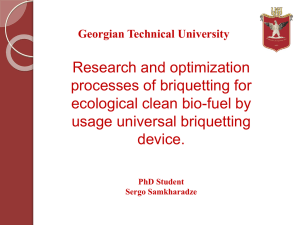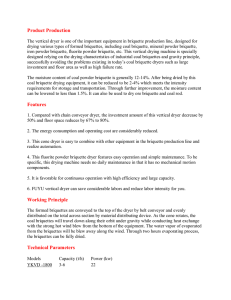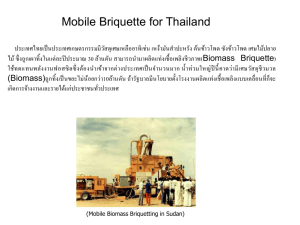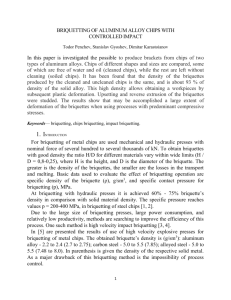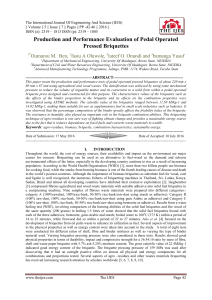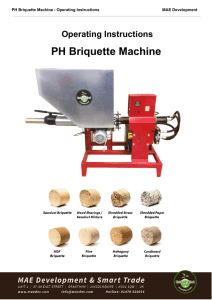DEVELOPMENT OF AN AUTOMATED BRIQUETTING MACHINE
advertisement
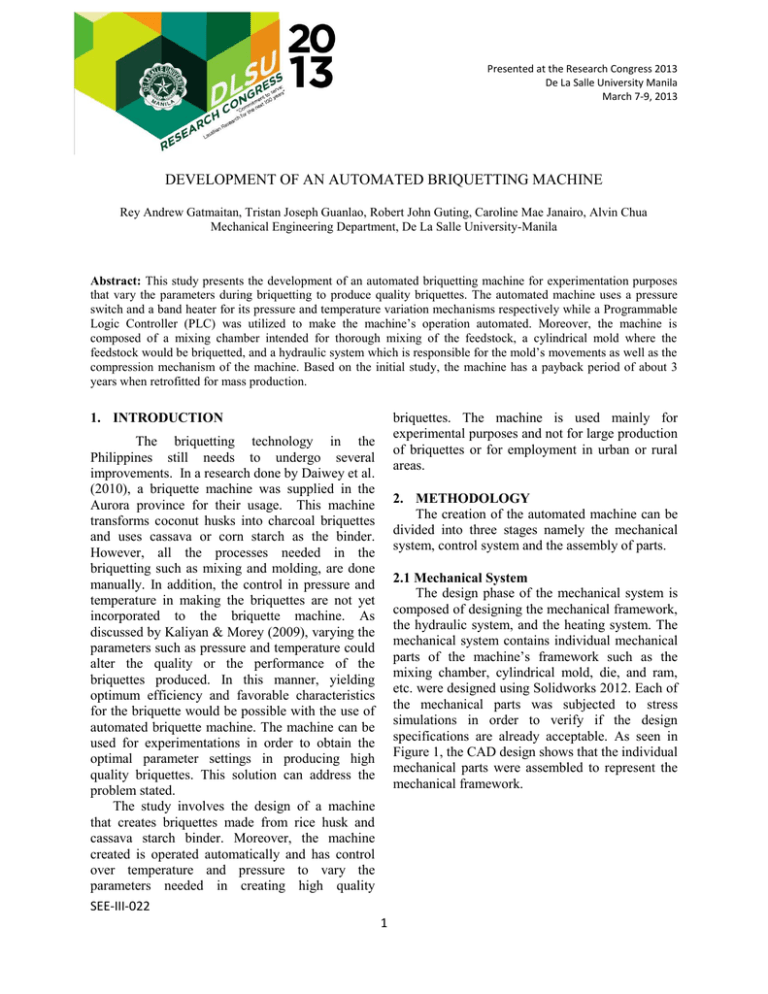
Presented at the Research Congress 2013 De La Salle University Manila March 7-9, 2013 DEVELOPMENT OF AN AUTOMATED BRIQUETTING MACHINE Rey Andrew Gatmaitan, Tristan Joseph Guanlao, Robert John Guting, Caroline Mae Janairo, Alvin Chua Mechanical Engineering Department, De La Salle University-Manila Abstract: This study presents the development of an automated briquetting machine for experimentation purposes that vary the parameters during briquetting to produce quality briquettes. The automated machine uses a pressure switch and a band heater for its pressure and temperature variation mechanisms respectively while a Programmable Logic Controller (PLC) was utilized to make the machine’s operation automated. Moreover, the machine is composed of a mixing chamber intended for thorough mixing of the feedstock, a cylindrical mold where the feedstock would be briquetted, and a hydraulic system which is responsible for the mold’s movements as well as the compression mechanism of the machine. Based on the initial study, the machine has a payback period of about 3 years when retrofitted for mass production. briquettes. The machine is used mainly for experimental purposes and not for large production of briquettes or for employment in urban or rural areas. 1. INTRODUCTION The briquetting technology in the Philippines still needs to undergo several improvements. In a research done by Daiwey et al. (2010), a briquette machine was supplied in the Aurora province for their usage. This machine transforms coconut husks into charcoal briquettes and uses cassava or corn starch as the binder. However, all the processes needed in the briquetting such as mixing and molding, are done manually. In addition, the control in pressure and temperature in making the briquettes are not yet incorporated to the briquette machine. As discussed by Kaliyan & Morey (2009), varying the parameters such as pressure and temperature could alter the quality or the performance of the briquettes produced. In this manner, yielding optimum efficiency and favorable characteristics for the briquette would be possible with the use of automated briquette machine. The machine can be used for experimentations in order to obtain the optimal parameter settings in producing high quality briquettes. This solution can address the problem stated. The study involves the design of a machine that creates briquettes made from rice husk and cassava starch binder. Moreover, the machine created is operated automatically and has control over temperature and pressure to vary the parameters needed in creating high quality SEE-III-022 2. METHODOLOGY The creation of the automated machine can be divided into three stages namely the mechanical system, control system and the assembly of parts. 2.1 Mechanical System The design phase of the mechanical system is composed of designing the mechanical framework, the hydraulic system, and the heating system. The mechanical system contains individual mechanical parts of the machine’s framework such as the mixing chamber, cylindrical mold, die, and ram, etc. were designed using Solidworks 2012. Each of the mechanical parts was subjected to stress simulations in order to verify if the design specifications are already acceptable. As seen in Figure 1, the CAD design shows that the individual mechanical parts were assembled to represent the mechanical framework. 1 Presented at the Research Congress 2013 De La Salle University Manila March 7-9, 2013 phase of the control system consists of determining the right type and specifications of each of the control parts and connecting it to form our main electrical system. The components are mainly composed of sensors, wirings, switches, indicator lamps, fuses and lastly Ladder Programming of the PLC. 2.3 Assembly of Parts All the accepted designs that have been generated from the previous steps will now be realized into actual parts which will then be assembled later on. All the important components of the machine such as the mechanical framework, hydraulics system, heating system, control system, and electrical parts will be actualized and later on be integrated all together to form the overall prototype of the automated hydraulic briquette press. This also includes checking every single part of the machine if it is working. To manually test whether the temperature that is said to be supplied by the band heater to the cylindrical mold is accurate, a K-type pocket thermocouple was used. The thermocouple was attached to the band heater as illustrated in Figure 2. The readings from the pocket thermocouple as well as the built-in thermocouple of the band heater were taken simultaneously and were recorded for further analysis. Despite that there were noticeable differences between the values of the readings of the built-in thermocouple and pocket thermocouple, these differences were kept under ±5% margin of error. Figure 1: Mechanical System Then, the design process for the hydraulic system consists of two main considerations: [1] the selection of appropriate hydraulics equipment for the system such as the pump, solenoid valve, piston cylinder, hoses, etc. based on the calculations made, design of pre-existing manually-operated briquette machines, and availability of supplies, and [2] the mounting and connection of these equipment in accordance with the machine’s overall operation. For the heating system, the study identified a manufacturer of a specific heating system that is applicable for the design. A band heater was chosen because of its applicability the system. A thermocouple is attached to the band heater to monitor its temperature, ensuring that what is being given off by the heater is within the threshold of the preferred parameter. With the desired maximum temperature of 300°C, the wattage and voltage of the heating system were determined and was eventually manufactured. 2.2 Control System On the other hand, the control system of the machine is composed of mainly of the electrical system which composed of sensors, switches, wiring, and ladder program. Basically, the design Figure 2: Setup in verification of the Band Heater SEE-III-022 2 Presented at the Research Congress 2013 De La Salle University Manila March 7-9, 2013 To proceed with the manual verification of the pressure switch’s accuracy, two Bourdon gauges were used. One gauge with a maximum pressure of 150 kgf/cm2 is mounted before the solenoid valve while the other gauge with a maximum pressure of 100 kgf/cm2 is located before the vertical hydraulic cylinder. These two gauges were used to verify the pressure setting on the pressure switch. The briquette Press Operation process involves three simple stages which are shown in Figure 3 and these stages are (1) feedstock preparation, (2) compaction, and (3) post processing the mold, it is simultaneously being heated by the attached band heater. The temperature, with a range of 30°C to 300°C, is controlled and monitored on a temperature controller. After the pre-heating period, the die then moves directly below the vertical hydraulic cylinder for pressing. The pressure as high as 95 kgf / cm2 (9 MPa) is set on the pressure switch and can also be monitored on the pressure gauges attached to the system. Once the feedstock is pressed, it then moves to the discharge outlet where it will be removed manually from the die. These operations are triggered and controlled on the control panel. There are switches which control the operation and fuses that ensure safety for the user. Post processing involves sun drying or artificial drying in order to improve transportability of the briquette produced. 3. Economic Evaluation Taking into account the machine expenses and the machine’s daily operation expenses such as electrical consumption, it was computed that the payback period will be achieved after approximately 3 years, a year shorter than that of the manual machine. This may be attributed to the relatively large initial expense needed for manual machines since it requires separate individual equipment such as the carbonizer. For the mass production automated machine, it can be seen that a capital of approximately Php 200,000.00 is needed, Figure 3: General stages of the Briquetting Operation The feedstock that will be loaded into the mixing chamber of the fabricated briquetting machine is a mixture of ground rice husk biomass and cassava starch that was made into a paste. The rice husk should be grounded first before mixing it with cassava starch and the reason for this is fundamentally for better and easier compaction. Then, the binding agent was made by mixing 100 mL of water and 35 grams of cassava starch are the ingredient needed to create the binding paste for the briquette. Then, the feedstock is loaded into the mixing chamber for thorough and further mixing of the feedstock as well as to prevent it from solidifying prior to its compression. From the mixing chamber, the feedstock will be conveyed to the mold through the guide tube with the aid of gravity. As it is accumulating inside SEE-III-022 Table 1: Cost of an Automated Briquetting Machine Mass Experimental Production Part Price Price Machine Fabrication 68,000.00 150,000.00 Heating System 6,224.00 20,000.00 Pressure Switch 6,500.00 6,500.00 Pressure Gauge 500.00 500.00 Electrical appurtances 3,000.00 3,000.00 (wires, switches, etc.) Solenoid Valve 0.00 8,000.00 Proximity Sensors 0.00 2,400.00 3 Presented at the Research Congress 2013 De La Salle University Manila March 7-9, 2013 PLC Total 0.00 84,224.00 10,000.00 200,400.00 In the case that a mass production machine(see Table 1) is fabricated based on the existing experimental automated briquetting machine, the payback of the machine is estimated to be achieved after 2.96 years or after selling 466,958.30 briquettes. 4.CONCLUSION A small-scale automated briquette machine that can produce briquettes automatically was designed and fabricated. It has sensors that can monitor the amount of feedstock in the mixing chamber and can inform the operator right away. Along with that, the primary operating parameters, temperature and pressure, can be varied through the control system utilized in the machine. The economic evaluation done shows the viability of an automated machine. 5. REFERENCES Baconguis, Santiago R. (2007). Abandoned Biomass Resource Statistics in the Philippines. Retrieved March 05, 2011 from http://www.nscb.gov.ph/ncs/10thNCS/papers/invit ed%20papers/ips-20/ips20-03.pdf. bdeee2_1.aspx Cheremisinoff, N., Cheremisinoff, P., & Ellerbusch, F. (1980). Biomass:Applications, Technology, and Production. New York, USA: Marcel Dekker, Inc. Daiwey, A. S., Rotaquio, E. Jr. L., Angara, E. V. (2010). Charcoal Briquetting Technology in the Province of Aurora, Philippines. ASCOT International Journal, SEE-III-022 4
